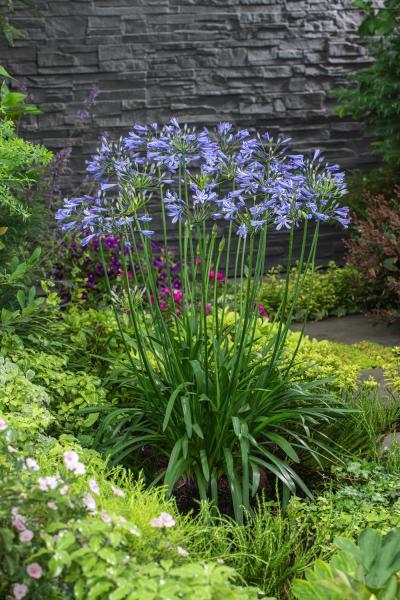Agapanthus Growing Conditions: Dirt, Sunshine, and Watering
Agapanthus Growing Conditions: Dirt, Sunshine, and Watering
Blog Article
Unleashing the Secret to Successful Agapanthus Farming: Tips and Tricks for a Flourishing Yard
In the world of horticulture, growing agapanthus successfully needs a critical approach that incorporates various aspects of plant treatment. By understanding the nuances of agapanthus farming, one can develop an environment where these plants flourish and flower generously.
Growing Agapanthus: Finest Practices
When growing Agapanthus, proper soil prep work is essential for guaranteeing effective development and development of these attractive flowers. Agapanthus, typically understood as Lily of the Nile or African lily, thrives in well-draining soil with a slightly acidic to neutral pH level - Agapanthus. Prior to growing, it is vital to change hefty clay dirts with raw material such as garden compost or peat moss to enhance drainage and supply important nutrients for the plants
To grow Agapanthus, choose a location that obtains complete sunlight to partial color, as this will certainly promote healthy and balanced growth and plentiful flowering. Dig a hole twice the size of the plant's origin round and position the Agapanthus at the exact same depth it was formerly expanding. Delicately backfill the opening with soil, pushing down securely to eliminate any kind of air pockets around the origins.
Water the recently planted Agapanthus completely and remain to keep the soil evenly damp, specifically throughout the plant's energetic expanding period. Agapanthus. Applying a well balanced fertilizer once a month can better sustain the plant's growth and flowering. By adhering to these best techniques for growing Agapanthus, you can create a spectacular display of these exciting flowers in your yard
Suitable Soil Issues for Agapanthus
For optimum growth and growing success of Agapanthus plants, making sure the soil conditions are ideal is vital. Agapanthus prefers soil that is abundant in nutrients, so including a balanced plant food during the growing period can advertise healthy and balanced growth and lively flowers.

Watering and Feeding Tips
To guarantee healthy development and lively blooms, proper watering and feeding methods are crucial for effective Agapanthus cultivation. Agapanthus plants profit from routine watering, especially throughout the expanding season.
When it comes to feeding Agapanthus, a well balanced fertilizer with equivalent parts nitrogen, phosphorus, and potassium can be applied in the springtime to promote healthy development and flowering. Slow-release fertilizers are ideal for giving nutrients progressively over an extended duration. Avoid over-fertilizing, as this can bring about extreme foliage development at the expenditure of blooms.
Furthermore, including natural matter like compost right into the soil can improve nutrient degrees and boost dirt structure, assisting in the general health of the Agapanthus plants. By complying with these watering and feeding suggestions, garden enthusiasts can ensure their Agapanthus plants thrive and create stunning screens of flowers.
Pruning and Deadheading Techniques
Appropriate trimming and deadheading techniques play an important duty in preserving the wellness and appearances of Agapanthus plants, matching the essential methods of watering and feeding for successful farming. Trimming Agapanthus involves eliminating spent blossom heads, dead or yellowing leaves, and total shaping of the plant to promote better growth. Deadheading, the procedure of getting rid of discolored flowers, not just enhances the plant's look but also motivates more flowering.
When deadheading Agapanthus, it is suggested to clip off the flower stem at the base utilizing sharp, clean shears. This process redirects the plant's power from seed production back right into origin and foliage growth, advertising a healthier and a lot more durable plant. Regular deadheading can prolong the flowering duration of Agapanthus and stop self-seeding, which can bring about find more overcrowding.
In regards to trimming, Agapanthus normally take advantage of a light trim after flowering to clean up the plant and encourage fresh development. Cutting back the spent flower stems and eliminating any damaged or dead foliage helps keep the plant's vitality and general appearance. Nevertheless, it is vital to prevent reducing into the crown of the plant, as this can weaken its health and wellness.

Protecting Agapanthus From Pests and Diseases
Implementing efficient pest and disease more information monitoring approaches is vital to securing the health and vigor of Agapanthus plants in growing. One common pest that impacts Agapanthus is the Agapanthus borer, a caterpillar that passages right into the plant, causing damages to the fallen leaves and flowers.
In addition to parasites, Agapanthus are susceptible to illness such as origin rot and fungal fallen leave spots. By staying cautious and resolving insect and condition problems quickly, gardeners can aid their Agapanthus grow and flourish.

Conclusion
In final thought, effective growing of agapanthus calls for correct growing methods, excellent dirt conditions, ample watering and feeding, normal trimming and deadheading, and defense from diseases and insects. By following these suggestions and techniques, garden enthusiasts can make sure a growing garden loaded with gorgeous agapanthus flowers. Agapanthus. Keep in mind to preserve constant treatment and focus to detail to advertise the health and wellness and durability of these stunning plants
When planting Agapanthus, correct dirt preparation is necessary for my review here making certain successful growth and growth of these beautiful flowers.Water the freshly planted Agapanthus extensively and proceed to keep the dirt uniformly wet, particularly during the plant's energetic expanding season.For optimal growth and flowering success of Agapanthus plants, guaranteeing the soil conditions are suitable is crucial. When transplanting or planting Agapanthus, ensure the dirt is well-prepared to provide the necessary foundation for the plants to establish themselves effectively. One typical insect that impacts Agapanthus is the Agapanthus borer, a caterpillar that passages right into the plant, causing damage to the leaves and flowers.
Report this page